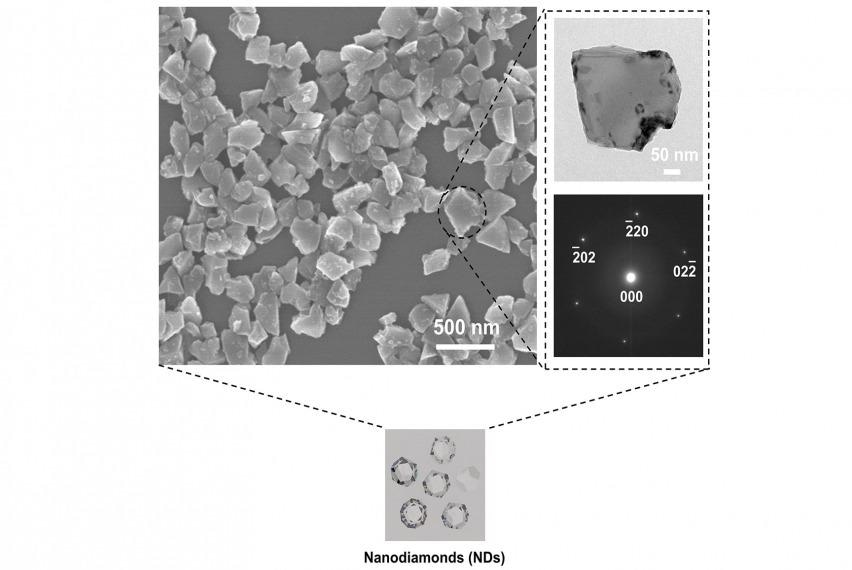Reviewed by Alex SmithSep 21 2021
Diamonds are valuable stones used in the jewelry and industrial sectors. Yet, in the foreseeable future, diamond nanoparticles, or nanodiamonds (NDs), may become the solution to mankind’s oral health.
 Nanodiamonds (Image Credit: University of Hong Kong)
Nanodiamonds (Image Credit: University of Hong Kong)
Oral diseases such as gum diseases, dental caries (decay) and fungal infections are huge health care problems worldwide, resulting in annual expenses of millions of dollars. However, there are still no proven solutions.
Complex microbes, normally occurring as disease-causing fungi and bacteria attaching to teeth surfaces and developing biofilm communities, are the pivotal reasons behind infections. According to the National Institutes of Health, biofilms are the cause of 65%–80% of all human infections.
In a journal article titled “Biofilm inhibition in oral pathogens by nanodiamonds,” researchers from the Faculty of Engineering and the Faculty of Dentistry of the University of Hong Kong (HKU) showed for the first time the inhibitory influence on oral pathogenic biofilms by high-pressure high-temperature (HPHT) NDs. The article was published in the journal Biomaterials Science.
Co-principal investigators of the study Dr. Chu Zhiqin, Assistant Professor of the Department of Electrical and Electronic Engineering; and Dr. Prasanna Neelakantan, Clinical Assistant Professor in Endodontics showed that NDs work as a functional agent against both attached cells (biofilm) and free-floating cells (planktonic cells) of fungi and bacteria that are very relevant in systemic and oral infections.
Specifically, they discovered the role of NDs in hindering biofilm formation and their disrupting impact on preformed biofilms in many selected orally and systemically vital organisms.
One of the most common diseases to affect humankind is dental caries, affecting over three billion people (48% of the population) across the globe. It is the result of the dominant acid-producing bacteria that form biofilms on the tooth surface.
Streptococcus mutans (S. mutans), a Gram-positive bacterium, is said to be the main cause for the commencement of this disease. Periodontal (gum) disease, which is the sixth most widespread disease in humans, with a global occurrence of 11.2%, is induced by Porphyromonas gingivalis (P. gingivalis), a Gram-negative bacterium.
Particularly, microbial dysbiosis in the oral cavity has been related to systemic illnesses such as Alzheimer’s disease, obesity and cardiovascular diseases. Microbes display high resistance to customary antibiotics and substitutes including nanotechnology are being exhaustively searched to discover better therapeutics.
Furthermore, fungal infections, another significant oral disease with recognized clinical implications, have witnessed no progress in the improvement of therapeutic drugs over the past several years.
Nano-materials are the hot topic in current materials science as these ultra-small particles can effectively penetrate into microorganisms and can also be used to carry a wide variety of drugs. Our research showed that these ultra-small nanodiamonds can manipulate genetic mechanisms in the pathogens and prevent their attachment to any surface, hence inhibiting biofilm formation in the oral cavity.
Dr. Chu and Dr Neelakantan, Study Co-Principal Investigators, University of Hong Kong
“The results of this exciting study demonstrated the great potential of NDs as an alternative therapeutic platform to prevent and treat oral infections. NDs possess many promising features including excellent biocompatibility and flexible surface properties. They are also proven to be very safe for humans,” they added.
Our work will promote a better mechanistic understanding of NDs on oral pathogens, paving the way for their clinical and translational applications.
Dr. Chu and Dr Neelakantan, Study Co-Principal Investigators, University of Hong Kong
This impact and knowledge regarding NDs can also be translated to treat other life-threatening infections in the body, particularly as antifungal drugs, for those susceptible to fungal infections, including the elderly and very young people, and those who are immunocompromised because of diseases such as diabetes and HIV infections, chronic users of steroids and patients with cancer undergoing chemotherapy.
Since fungal cells are quite like human cells, developing antifungal agents that are not detrimental to humans has continuously been a huge challenge.
Journal Reference:
Zhang, T., et al. (2021) Biofilm inhibition in oral pathogens by nanodiamonds. Biomaterials Science. doi.org/10.1039/D1BM00608H.